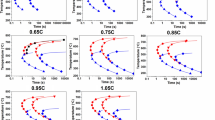Mathematical modeling of the process of quenching of axisymmetric industrially quenched steel bars is performed with the use of the finite-element method. The model is checked by comparing the results of the temperature simulation with data of simulation by the ANSYS commercial finite-element software.





Similar content being viewed by others
References
S. Moaveni, Finite Element Analysis: Theory and Application with ANSYS, International Edition (2008).
Mohamed Elshayeb and Yea Kaim Bing, Application of Finite Difference and Finite Element Method, University Malaysia Sabah Kota Kinabalu (2000).
B. Smoljan, “Mathematical modeling of austenitic decomposition during the quenching,” in: 13th Int. Sci. Conf. on Achievements in Mechanical and Materials Engineering (2005).
Abdlmanam S. A. Elmaryami, Heat Treatment of Steel by Developing Finite Element Mathematical Model and Simulation, Master’s Thesis, University Tun Hussein Onn, Malaysia (2010).
Liscic Bozidar, “System for process analysis and hardness prediction when quenching axially-symmetrical workpieces of any shape in liquid quenchants,” J. Mater. Sci. Forum, 638–642 (2010).
Rong-Iuan Hsieh, Horng-Yih Liou, and Yeoang-Tusen Pan, “Effect of cooling time and alloying elements on the microstructure of gleeble-simulated heat-affected zone of 22% Cr duplex stainless steels,” J. Mater. Eng. Perform., 10(5), 526–536 (2001).
Abdlmanam S. A. Elmaryami, Sulaiman Bin Haji Hasan, Haji Badrul Bin Omar, and Mohamed Elshayeb, “Unsteady state hardness prediction of industrial quenched steel bar (one and two dimensional),” in: Materials Science and Technology 2009, Conference and Exhibition, Pennsylvania, USA (2009).
B. Smojan, “Prediction of mechanical properties and microstructure distribution of quenched and tempered steel shaft,” J. Mater. Process. Technol., 175(1–3), 393–397 (2006).
A. Rose, et al., Atlas zur Wärmebehandlung der Stähle. I. Verlag Stahleisen, Düsseldorf (1958).
B. Smoljan, “Mathematical modeling of austenite decomposition during the quenching,” in: 13th Int. Sci. Conf., The Polish Academy of Science (2004).
Haji Badrul Bin Omar, Mohamed Elshayeb, and Abdlmanam S. A. Elmaryami, “Unsteady state thermal behavior of industrial quenched steel bar,” in: 18th World IMACS /MODSIM Congress, Cairns, Australia, 13–17 July, 2009 (2009).
B. Donnay, J. C. Herman, V. Leroy, et al., “Microstructure evolution of C − Mn steels in the hot deformation process,” in: The Stipcam Model, CRM, Belgium, THYSSEN STAHL AG, Germany.
B. Smoljan, D. Iljkic, and Hanza S. Smokvina, “Computer simulation of working stress of heat treated steel specimen,” J. Achiev. Mater. Manuf. Eng., 34(2), 152–156 (2009).
Author information
Authors and Affiliations
Corresponding author
Additional information
Translated from Metallovedenie i Termicheskaya Obrabotka Metallov, No. 4, pp. 48–51, April, 2013.
Rights and permissions
About this article
Cite this article
Elmaryami, A.S.A., Elshayeb, M., Omar, H.B.B. et al. Development of a Numerical Model of Quenching of Steel Bars for Determining Cooling Curves. Met Sci Heat Treat 55, 216–219 (2013). https://doi.org/10.1007/s11041-013-9608-6
Published:
Issue Date:
DOI: https://doi.org/10.1007/s11041-013-9608-6




